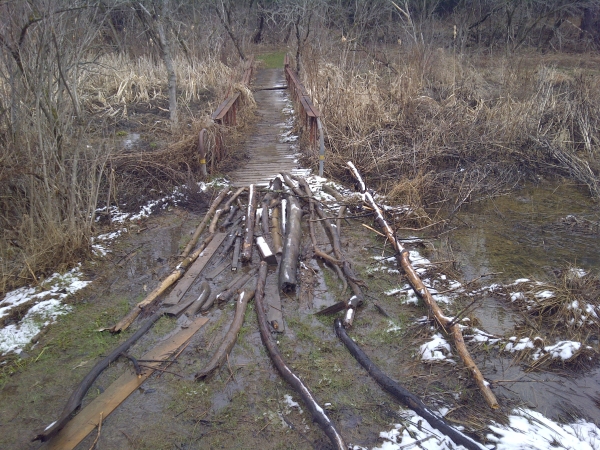Is It A Marsh?

About this marsh
The wetlands that you see here are currently in transition. The geological process that you have the opportunity to witness here is the formation of a marsh. This freshwater marsh here is being formed by both standing water and inflowing water from the surrounding area. Surface-water levels change seasonally. Flooding occurs in times of high rainfall during. During dry periods the water level here diminishes often exposing matted vegetation or mud. Here you will see the formation of mosaic surface patterns made up of pools or channels interspersed with clumps of emergent sedges, grasses, rushes and reeds, with bands of shrubs found along some of the edges. You will also see submerged aquatic plants where pooling of water occurs and if you come during the summer or fall you may also see floating aquatic plants which should be increasing in numbers over the forthcoming years.
Beavers, man and nature are all playing an important role in the formation of this marsh. Due to the topographic nature of this area, the width of the marsh will remain fairly unchanged over the years, however the length of the marsh will increase over time and you can watch it grow and develop in the future years. Beavers dam up the watercourse. Man has had a recent and direct impact on the increased amount of water here by increasing the flow of runoff from the nearby subdivision into Marigold Creek. With these two primary factors, it is now easy for nature to take it's course in the transition of this area to a full fledged marsh.
Characteristics of a marsh
A marsh is a type of wetland. The 4 principal types of wetlands are: marsh; swamp; bog; fen. These wetlands are differentiated by such factors as types of vegetation, acidity and amount of water.
Marshes have: Differing water levels, depending on time of year (rainfalls and snowmelt);
Vegetation, including cattails and marsh marigold at the edges;
And they are relatively shallow.
During dry periods they are, at least, waterlogged.
So is this area a marsh yet?
Still can't decide if this is a marsh? Consider the following:
Marshes have an assortment of grasses, reeds, and sedges, yet without large bushes or tall trees.
The height of standing water can range depending on the location and season.
The mud or clay that forms the base of the marsh is always heavily saturated.
There is often a large space of open water where birds will colonize.
A marsh provides a vital habitat for many plant and animal species, as well as protecting neighbouring areas of land from flooding.
Plants that live in marshes are adapted to changing water levels. They tend to be very hard and have broad leaves.
Have you learned enough from the cache description and by visiting the location to know about the formation and transition of this wetland?
In order to log this earthcache you will need to perform the following tasks and email me the answers.
a) From your observations while visiting this earthcache, identify 3 characteristics that you see that make this a marsh.
b) Standing near the information sign facing the marsh, determine and explain in what direction the water is currently flowing. You may want to put a small twig into the water to observe the flow, if any.
c) Determine the current depth of the marsh at the center of the bridge.
d) What is the name of this watercourse and where does it connect to another main watercourse?
e) When and under what conditions is there more water here?
f) Calculate the approximate surface area of the water and estimate at what percentage the surface area will increase (or decrease) over the next 10 years.
g) Specify all of the different types of plants and animals you see within this marsh habitat. If you are unsure of their names, describe them.
h) Are those cattails or bulrushes in the marsh?
I hope you are curious and come back in the years to come to see the marsh and how it has changed.
This cache was placed under direct supervision of park staff. Please use the provided trails and visit this eocache only during park hours.